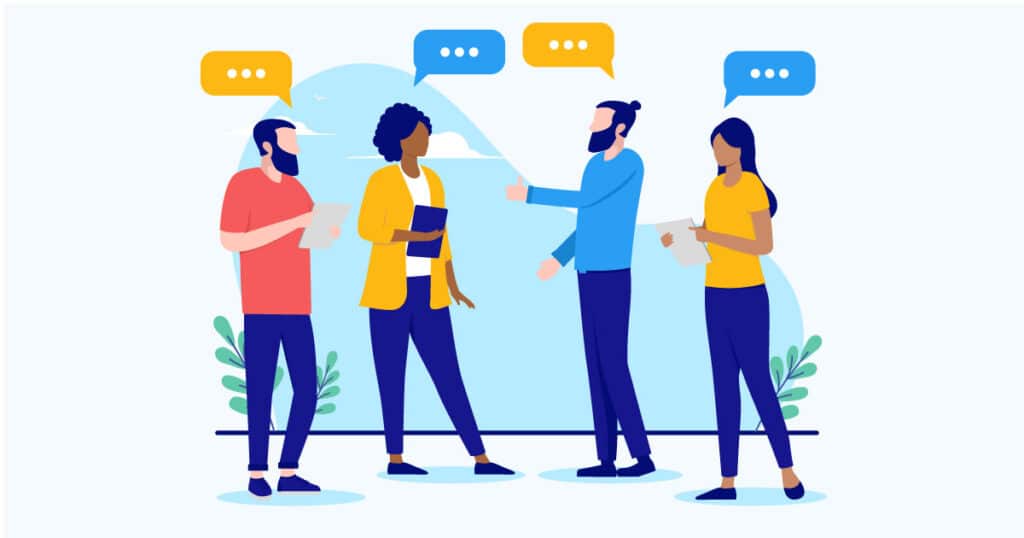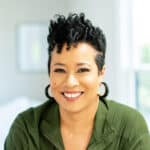Amber Cabral on Strategies for Speaking Up, Building Connection, and Creating Equity

Photo credit: iStockphoto.com (Overearth)
Amber Cabral is an award-winning inclusion strategist, certified coach, speaker, and author of two books, most recently Say More About That: And Other Ways to Speak Up, Push Back, and Advocate for Yourself and Others.
Formerly a Diversity Strategist at Walmart Stores, Inc., she founded Cabral Co., an equity and inclusive leadership-focused consulting firm, to help organizations ignite behavior shifts that create inclusive workplace cultures.
Also a Conference for Women speaker, she spoke with us recently about strategies for speaking up, building connections, and creating equity.
CFW: I love your message: “I fight for fair.” And you do this by teaching others how to speak up and advocate for themselves and others. Let’s talk about the landscape before we get into the hows. What makes it so daunting?
A lot of things. The first thing is people are afraid of being retaliated against. They think, “What if I say a thing and people disagree with it? Now, I’ve put my job at risk. Or I don’t feel like a part of the culture.”
The second thing is people need more clarity about what they are uncomfortable with. In American culture especially, sometimes we feel discomfort, but it’s hard for us to articulate the why, so we avoid it so we don’t have to figure out the why. Then, we don’t get to confront it and advocate for what equity would look like in that circumstance.
For example, a young person did something in my business, and another colleague didn’t appreciate it. They weren’t clear about what they didn’t appreciate. Instead of querying it and deciding to say this is how I prefer you handle me and my work, they elected to say I’m just not going to engage with her.
Many people do that. I don’t like how that felt. I’m not going to engage instead of deciding to say what I am uncomfortable with because, very often, people just need some feedback or insight, and they can adjust their behavior, and you can continue shining and doing what you are great at.
Instead, we will remove ourselves from spaces, opportunities, and connections because we are uncomfortable with something and haven’t figured out why.
CFW: Some kind of retaliation is what people are most concerned about. However, evaluating the risk of something like that can be complicated. What do you recommend for how people can evaluate what is a genuine risk and what is something else?
I always say to ask some questions. If you aren’t sure where you are or how you feel, it’s because you need to ask questions. And those questions don’t have to be accusatory. They can be the title of my book, Say More About That.
You can be clear when someone gives you more information: “Oh, the place I disagree with you is here. Or the things that make me uncomfortable are when you say this.”
In my mind, it’s a better solution to say, “Help me understand more of what you want to get out of this,” rather than just shutting everyone down. I think questioning in an open, broad, curious way.
CFW: How we speak up is a significant factor in the risks or benefits of doing so. What are some of the key strategies you recommend?
The first thing I always recommend is that people lead with curiosity. Turn on the way you turn it on with children in your life. If they approach you with a new toy, you say, “Where did you get that?!” That works for adults, too. I think we can better highlight where we are genuinely curious. That opens doors. People want to answer you.
Another thing is our body language. Body language can do a lot of work for you, too. And a lot of research says people read body language first. So, if you know that you’re trying to create a sense of synergy or connection or overcome an obstacle, approach with the energy that is likely to get you there: No folded arms.
CFW: I appreciate what you say, “I ignite people to live their most authentic and impactful lives while creating that same space for others.” That combination is so beautiful. I’m curious what you’ve learned about focusing on both dimensions and what you get from it.
First, I think it’s important to recognize vulnerability is not a weakness. It’s a strength. So, one of the things that I do is try to bring out my vulnerability. I share my personal story. I highlight the ways I’ve made mistakes and overcome them. I explain whatever challenges I might be navigating.
I would show up to trainings and let folks know, “Listen, I lost my dad this year. The energy you get from me may feel a little different.”
Vulnerability is the key to unlocking connection because others feel more human when we see humanness. Otherwise, we walk into these spaces, and it’s a bunch of suits, and we think, how are we supposed to act when we’re in a suit?
It creates additional silos. It keeps people from having meaningful conversations. And it puts us in a position to reinforce the idea there is no space for who we are. Role modeling is critical: leading with vulnerability, candor, and openness.
CFW: Let’s go a little further because many people focus on creating change or personal advancement. What I love about your work is the unity. What do you get out of holding both?
A lot. While I don’t have children, I do believe mentally in legacy. When you think about a legacy, it means people are still talking about what you did and your impact. I can’t have a legacy without other people. The more I can connect and help people understand my work, the more people I get interested in talking about it and behaving in ways that align with what equity can look like, and the bigger my legacy.
The world is also better for me, you, and, if you have them, your kids. And so I operate from the perspective that both agendas are important. My individual well-being, success, and impact matter. But my well-being, success, and impact are only as big as I am willing to extend opportunities for others to do that, as well.
